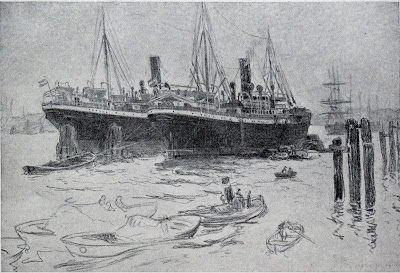Carlos Grethe
(Montevideo 1864 - 1913 Nieuwpoort Be.)
German painter and etcher
&
Martin van Waning
(the Hague 1889 - 1972 Dokkum, buried Schiermonnikoog)
Dutch painter, etcher and sculptor
Portraits of Grethe by Bernard Pankok (1872-1943) and van Waning from his tombstone.
His portrait by Emil Orlik with whom he co-founded the Berlin Secession in 1907.
This is a humble attempt linking the lives and careers of two artists, at first sight separated by time and distance and who are each individually interesting enough for a personal biography*below. In three small postings and within the confinements, limitations and narrow space of this Blog this is not an easy task. But this story is well worth sharing so here goes.
Reading and studying the Hamburg artists and visiting their world roughly around the turn of the 19th into the 20th century (before post), printmakers, painters, world trade, big money, prosperity and fine museums, one is bound to meet Carlos Grethe, the painter of oceans and seas and of the world largest and busiest port, its workers and its atmosphere. After a sister and a brother Carlos Grethe was born in Montevideo, Uruguay, the family returning to Hamburg in 1869.
He studied in Hamburg "Kunstgewerbeschule" and later in Frankfurt Art Academy and was appointed professor in Karslruhe returning often to his native Hamburg to paint and with his students he founded a painters colony in Duhnen near Cuxhaven on the North-sea coast, where river Elbe meets the sea.
He was a friend of the world largest private ship owner and largest West-Africa trader Adolph Woermann (1847-1911), who lived near Cuxhaven. Woermann enabled him to travel the oceans in his ships. I bet Woerman will have seen his ocean liners set of to and return from the America's with passengers and his tall ships to and from Africa for trade like in this postcard photograph.
He was a friend of the world largest private ship owner and largest West-Africa trader Adolph Woermann (1847-1911), who lived near Cuxhaven. Woermann enabled him to travel the oceans in his ships. I bet Woerman will have seen his ocean liners set of to and return from the America's with passengers and his tall ships to and from Africa for trade like in this postcard photograph.
Later celebrated painter and printmaker Wilhelm Laage was Grethes student but also was Heine Rath (who like Grethe was awarded a professorship in Karlsruhe) and Karl Otto Matthaei.
In his paintings deepest respect for the greatness of the oceans is always present, and also for the the hard working seamen, harbor laborers, and fishermen. Grethe witnessed the period of transition: from sail to steam. I bet Grethe knew the (quite dramatic) work of his American colleague Winslow Homer (1836-1910), below:
He died in Nieuwpoort (at the sea in Belgium) from the complications of an appendix operation only 50 years old.
He died in Nieuwpoort (at the sea in Belgium) from the complications of an appendix operation only 50 years old.
Hans W. Singer, foremost German art historian and art critic, was a great admirer of Carlos Grethe and wrote a lyrical article on Carlos Grethe in the Studio 1904 (and later in 1910 and after his death) and this was where I saw this picture of a sketch by Grethe of Hamburg harbor which made me wonder. I picked this volume up last year in a car boot sale.
I could not find a painting made after this sketch, this is an example that probably comes closest. Do return in a few days for part II of an amazing story, and a discovery never discussed before.
---------------------------
All pictures borrowed freely from the Internet for friendly, educational and non commercial use only.
* Ingrid Stocke: Carlos Grethe 1864-1913, "Leben und Werk, der Maler des Meeres", 2008











No comments:
Post a Comment